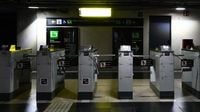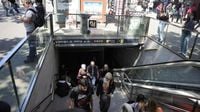Barcelona faced an unprecedented crisis on Monday, April 28, 2025, when a massive electrical blackout struck the entire Iberian Peninsula, halting all metro operations in the city and leaving millions stranded. The power outage began around 12:30 PM, leading to immediate chaos as public transportation systems collapsed and commuters scrambled for alternative means of travel.
As the blackout unfolded, Transports Metropolitans de Barcelona (TMB) was forced to evacuate passengers from 24 trapped trains, with many stuck between stations. Xavier Flores, the CEO of TMB, described the situation as "unprecedented," noting that it was the first time all lines had simultaneously stopped for such an extended period. The urgency of the situation was palpable as employees, police, and firefighters worked tirelessly to ensure the safety of those affected.
With the metro system paralyzed, the city’s streets became gridlocked. Traffic lights were out, causing significant disruptions across major routes. In response, the city deployed 900 buses to help maintain some level of public transport, as Mayor Jaume Collboni emphasized the importance of buses in providing mobility. "We have 900 buses functioning to guarantee mobility," he stated during a press briefing.
Despite these efforts, the impact of the blackout was felt far beyond transportation. Communication systems were severely disrupted, with intermittent phone service and limited internet access hampering both citizen communication and emergency management. As the hours passed, the situation remained critical, with only 41% of Catalonia's electrical grid restored by early evening.
As night fell, the city’s emergency response teams worked diligently to address the fallout from the blackout. The Generalitat of Catalonia aimed to restore normalcy by the following morning, although officials, including Salvador Illa, cautioned that they could not guarantee complete restoration. The City Council activated the Municipal Civil Protection Plan, urging residents to remain calm and exercise caution.
In a bid to provide shelter for those unable to return home, the city opened three sports centers: Can Ricart, Estació Nord, and Can Dragó. Collboni reassured the public that these facilities would be available for those in need of a place to sleep.
Meanwhile, hospitals operated without interruption thanks to backup generators, allowing them to continue critical procedures, although non-urgent operations were postponed. The mayor noted that the city was facing difficulties in water supply, particularly in higher areas, due to reliance on electric pumps.
By late evening, TMB reported that service had been restored on several lines, including Line 1, which was operational between Hospital de Bellvitge and Fondo, albeit with some limitations. Lines 3, 4, 5, 9, and 10 also resumed partial service, although many trains continued to bypass certain stations.
As the city braced for the next day, the mayor confirmed that eight out of ten traffic lights were operational again, signaling a slow return to normalcy. However, the situation remained complicated for long-distance and Rodalies trains, which continued to be suspended, affecting many commuters and students in the metropolitan area.
As Tuesday, April 29, dawned, the recovery efforts continued. TMB announced that the metro had fully resumed normal service across its network, with all lines operational. This included the TRAM service, which was functioning normally on lines T1, T2, and T3, while lines T4, T5, and T6 were restored with adjusted frequencies.
Despite the restoration of metro services, Rodalies trains remained suspended due to ongoing instability in the electrical network. The situation was a stark reminder of Barcelona's reliance on its public transport system, which serves approximately 1.6 million passengers daily.
In the aftermath of the blackout, the city faced significant challenges, including traffic congestion and economic impacts, as many businesses remained closed due to the disruption. The Seat plant in Martorell and the Ebro plant in the Zona Franca halted production, illustrating the broader economic ramifications of the blackout.
As the city worked towards full recovery, the chaos at Barcelona-El Prat Airport highlighted the extensive impact of the blackout. Although initial operations continued without major issues, delays of over three hours and numerous flight cancellations began to accumulate as the day progressed.
In summary, the blackout of April 28, 2025, posed a significant challenge for Barcelona, disrupting daily life and highlighting the city's dependence on its electrical grid and public transportation systems. The city's response demonstrated resilience and adaptability, as officials worked tirelessly to restore services and provide for those affected by the crisis.






